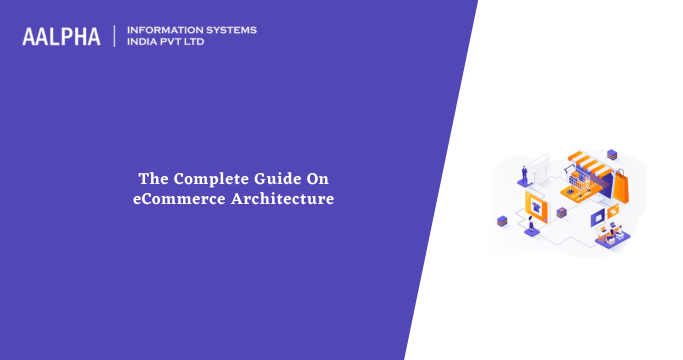Online infrastructure is essential for every successful e-commerce venture. The architecture of an eCommerce platform is crucial. The venue a business employs to do e-commerce deals with fundamental features that impact performance and ultimately determine the course of the company’s future.
We will go over the concept of an ecommerce website’s architecture, its kinds and levels, as well as the necessary components and some helpful planning pointers in this piece. The contemporary ecommerce system and its significance will be explained, and the optimal strategy for running an online store will be outlined for you. This article will help you discover the answers to your technical problems whether you are ready to begin a new ecommerce project or are considering re-platforming.
E-Commerce Architecture
The term “ecommerce website architecture” refers to the systematic organization of the site’s content. It also establishes a structure for the relationships between the data chunks.
In other words, it is a method for organizing a website so that it may serve its intended purpose and aid in the achievement of business objectives.
What Makes a Website Sell More Online?
There are already between 12 and 24 million online shops, and that number is growing exponentially every day. Despite their differences, all popular websites have commonalities. In this article, we will go over the best practices and characteristics that your eCommerce website should have.
Most customers want a shopping experience that is quick, simple, and convenient on your eCommerce website. Customers want to be able to browse your collection with a single swipe swiftly. In turn, this will have a beneficial effect on your earnings. Your design should, first and foremost, have a distinct route for the buyer’s journey. When people click on your ads or links, what will happen to them? Where should they go from there, exactly? How do you plan to walk them through making a payment?
The usability of your website is greatly influenced by its structure and design. Provide a search box, organize your goods into categories, highlight featured items in the sidebars, and make your navigation bar simple to use. The components above will work in tandem to ease the way for your visitors to convert. The inability to locate desired items is a significant contributor to shoppers leaving an online store. A well-organized website makes it easy for users to discover the information they need.
Consider the Brand’s Visuals
Most visitors judge a website only on its appearance and only pay regard to its backend once it’s too late. The solid foundation should remain, but the experience should be elevated via the use of eye-catching images.
Your logo, characteristic colours, font, icons, etc., should all be included in your eCommerce site design. Your website’s design will immediately benefit from this addition. A professional site will also have visual consistency, which you may achieve by applying brand components consistently throughout the pages.
A design brief outlining where and how your brand aspects should be used is essential when working with an eCommerce web design business.
Keeping It Accessible May Help A Lot
Users favour uncluttered, easy-to-navigate websites over complex ones because it’s less stressful to hunt for specific information when there isn’t a lot going on. The guest’s decision-making process could be improved by the abundance of visual cues, text boxes, and calls to action. A page layout with purposeful language, fewer visuals, enough white space, and a single focal CTA produces a far more pleasant experience.
Make sure the focus is on the most critical parts of your message and sales pitches. Your customers will have a lot easier time understanding your statement if there are fewer buttons to click and fewer images to travel through.
Photos Are Supreme
Okay, hear us out: We would never downplay the importance of outstanding content, but when it comes to eCommerce site design, photography must take a backseat to content. You may have observed that the majority of online stores centre their content on visuals. Many sites, like Maybelline’s, include an enormous banner picture of their newest or most popular product. As you go throughout the site, you’ll see more realistic portrayals of the items in use.
First, pictures are essential for online stores since they help establish credibility. Photos are the only method for online shoppers to acquire a feel for a product since they can’t touch and scrutinize it in person. Therefore, well-staged, well-photographed images are crucial for online shop layouts. Several photographs showcasing the goods from various perspectives should be shown for each item. Allowing viewers to zoom in as much as they want to have a better look at the product is preferable.
Choose the Features of Your eCommerce Website
Selecting the features you want for your eCommerce website might be challenging! When starting an online business, having integrated marketing tools and dependable payment processing is essential to getting the most value for your money. Additionally, choose a online platform that you are comfortable with and can manage.
By doing this, you can assist in making sure everything runs well during busy times and provide dependable customer service in case anything goes wrong. Remember to stay current with industry trends. Staying ahead of the competition might enable you to provide a better shopping experience, which would increase sales!
The Value of an E-Commerce-Based Infrastructure
Solid eCommerce architecture is essential for expansion. If you wish to open an online shop, you should utilize it. Here, then, are a few of eCommerce’s architectural benefits.
Improving Satisfaction of Customers to Increase Profits
The success of your online store depends on the quality of the customer service you provide. Customers want streamlined, trouble-free online shopping experiences. Providing a satisfying online shopping experience relies on a well-designed eCommerce platform. From the homepage to adding an item to their shopping basket, users should be able to navigate your site swiftly.
Enhanced Positioning and Indexing in Search Engines
Google Sitemaps is a tool for creating sitemaps, which may aid with search engine optimization and indexing.
Superior Scalability
The structure of an E-Commerce platform is such that it may be updated without starting from scratch. To accomplish so, however, requires knowledge of precisely which parts and architecture of the websites need enhancement.
It’s Simple To Include Third-Party Software
Understanding the links and interdependencies in your eCommerce software architecture will allow you to implement solutions from several vendors for a more satisfying shopping experience for your consumers.
What Is The E-Commerce Framework’s Layer Count?
There are two main aspects to any ecommerce software architecture: the front end and the back end (two-tier architecture), and three main pieces to any ecommerce framework:
-
Layer of Presentation
The website, layout, UI, personal account portal, and any other parts of the system that end users may access are all part of the user-facing layer.
-
Layer of Applications
Business logic and other backend activities, such as those involved in managing product catalogues, shopping carts, payment processing systems, and order tools, are often handled by an application layer.
-
Layer Of Data
All the information necessary to run an online shop is kept here. Information like products, customers, and order histories are all part of this data.
Microservices Architecture for Electronic Commerce
The microservices architecture is a crucial component of any successful eCommerce platform. Microservice architectures allow for the decomposition of complex systems into a collection of smaller, more manageable pieces. Payment processing, inventory management, and hosting are all examples of services in this category. Scalability is improved, and problems with individual services are less complicated to isolate when this design is put into practice. In addition to these advantages, each microservice may be individually scaled up or down as needed. This is especially useful when one service, such as payment processing, is more efficient than the others are.
The Architecture of Headless Commerce
Decoupled eCommerce design, or “headless architecture,” divides the purchasing and shipping phases of an online store. Customers expect quick and easy transactions when they purchase online. Because of this, headless commerce has exploded in popularity among many eCommerce platforms.
Your store’s front end may be adjusted to fit any screen size or form factor, making it suitable for both desktop and mobile usage. Meanwhile, the back end may be altered to accommodate any order processing method. What is the most attractive feature of the headless business system? It can be easily expanded and is cheap. A superb bespoke solution may be an upgrade or modification to the backend that does not affect the front end.
Costs are reduced in comparison to other architectures like monolithic eCommerce design, where changes need significant modifications to both the front- and backends due to the fact that only minor adjustments need to be made between each update or change to the backend system.
Prerequisites for an Online Shop Website
eCommerce websites should be user-friendly, contemporary, versatile, and highly easy for clients. Here, we have compiled some suggestions for the components that an e-commerce site should typically feature:
-
Catalogue of Goods
Ensure your platform supports the creation of a product library that can be easily searched and filtered by clients.
-
Checkout And Shopping Basket
Customers should be able to make purchases with confidence thanks to a straightforward and user-friendly shopping cart and checkout experience on the website.
-
Transaction Handling
Customers should be able to use their chosen payment methods (such as credit cards or PayPal) on a safe and dependable payment system integrated into the website.
-
Choices in Shipping and Delivery
E-commerce platforms can only succeed with a reliable shipping and delivery system that gives consumers options. For efficient route planning, consider utilizing an app for Android.
Providing devoted support is an integral aspect of any client experience. Make sure you’re able to provide valuable tools and resources like a FAQ, a contact form, and a variety of support choices.
-
Produce Microservices for Online Stores
For example, if your site’s product pages depend on a single API database and that database goes down, then all of your product pages will be unavailable. With a microservices design, every page and feature can function independently, eliminating the dependency that caused the issue in the first place. Consider microservice architecture while planning the back end of your website, particularly with regard to product and stock management.
-
Online Shop Web Designer vs. Do-It-Yourselfer
A minor to medium-sized firm won’t have the resources to hire a full-fledged eCommerce development team consisting of programmers, UI/UX designers, graphic designers, copywriters, and so on. However, this should allow you to do the latter!
You might also engage a company that specializes in eCommerce web design to do everything from scratch. In order to get the most out of your online store, it’s best to hire a skilled eCommerce web design firm.
-
Improvements to the Structure of eCommerce Software
Optimizing the architecture of online marketplaces saves time, money, and resources, allowing for a quicker time-to-value. This is the most effective strategy for improving CX and creating a market disruption.
Optimization of business logic facilitates simplification of operations, enhancement of efficiency, and extension of services to consumers.
When modules are optimized, chances for scalability and adaptability are increased. The Virto commerce modular architecture, for instance, lets you scale up your capabilities when they’re required (like on Black Friday) and scale them back down when they’re not.
You should invest in a system that can automatically optimize your data when it’s required to save money on the costly process of data optimization. Best-of-breed tier optimization: if you’re utilizing an API-based solution, you can quickly swap in newer, more effective offerings from third-party providers as they become available.
Conclusion
You need the ideal eCommerce team structure, staffed with the most qualified individuals, to achieve your goals. The introduction of online shopping has wholly altered the commercial landscape. Merchants may now buy and sell things on a global scale with unprecedented ease after spending years following conventional sales channels.
Companies have gained customers they never would have imagined, while consumers have reaped the benefits of more variety, simplicity of use, and, most crucially, reduced pricing.
Connect with our web development company : Aalpha to know more about eCommerce Architecture.






Share This Article:
Written by:
Stuti Dhruv
Stuti Dhruv is a Senior Consultant at Aalpha Information Systems, specializing in pre-sales and advising clients on the latest technology trends. With years of experience in the IT industry, she helps businesses harness the power of technology for growth and success.
Stuti Dhruv is a Senior Consultant at Aalpha Information Systems, specializing in pre-sales and advising clients on the latest technology trends. With years of experience in the IT industry, she helps businesses harness the power of technology for growth and success.